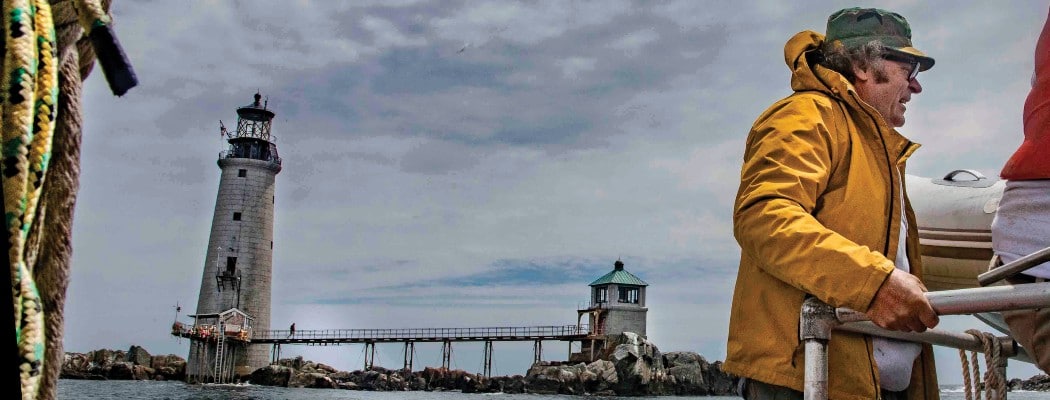A group of Nantucket craftsmen help give new life to a historic lighthouse in Boston Harbor.
 You’ve just bought a decrepit lighthouse, nine miles out to sea, perched atop nothing more than an outcropping of rocks peeking out of the water at the entrance to Boston Harbor. Who do you turn to for help in refurbishing it, to transform it from a crumbling, hundred-foot ruin into a ship-shape weekend getaway? If you’re visionary businessman Dave Waller, who purchased Graves Light Station from the U.S. Coast Guard in 2013, you turn to your brother-in-law, Nantucket cabinetmaker and general contractor Karl Phillips of Driftwood Construction.
You’ve just bought a decrepit lighthouse, nine miles out to sea, perched atop nothing more than an outcropping of rocks peeking out of the water at the entrance to Boston Harbor. Who do you turn to for help in refurbishing it, to transform it from a crumbling, hundred-foot ruin into a ship-shape weekend getaway? If you’re visionary businessman Dave Waller, who purchased Graves Light Station from the U.S. Coast Guard in 2013, you turn to your brother-in-law, Nantucket cabinetmaker and general contractor Karl Phillips of Driftwood Construction.
“Karl opened the door for so much talent to come off the island and work on this thing,” Waller says. “Nantucketers are a hearty bunch, so that probably has something to do with it, and they knew how to do things the old way. Just look at the craftsmanship of the houses on Nantucket. That’s why Graves is almost a Nantucket-built lighthouse now.”

This hearty group of Nantucket craftsmen includes Peter Lochtefeld, Ben Moore, Charlie Stewart, Mark Wursten, Fazoul Eshulunkov, Mark Golaski, Emerson Belli and Will and Peter Phelps. Alison MacDonald and Kathrine Moore of ACKfire Studios cast more than one hundred custom glass pieces for the bronze walkways in the lantern room, creating a stained-glass effect.

“Getting people to do this at all was maybe the biggest challenge,” Waller says. “You can’t just throw a ton of money at a project like this. The people working on it have to be invested, and all these artisans from Nantucket are.”
When the beacon was originally erected on Graves Ledge in 1903–05, it was one of a handful of “landfall lighthouses,” isolated out at sea. In its day, it was a marvel of engineering, requiring its builders to work below the waterline, erecting a coffer dam around the site to sink the footings into the basalt bedrock on which it stands. It was also widely considered to be the most beautifully appointed lighthouse on the East Coast, and Waller’s intention was to return it to that status, and then some. The original Fresnel lens, which is now in the Smithsonian, will be replaced by an updated, solar-powered version, because, in addition to using the lighthouse as his second home, Waller is committed to keeping it operational. “The ledge is a hazard to navigation,” he says, “and the light is an important tool for mariners.” One need only look at the long list of shipwrecks over the centuries to appreciate the truth of that statement.
 The Coast Guard operated Graves until Waller and his wife, Lynn, a RISD-trained designer, bought it at auction for $933,888. They were eventually joined by partner Bobby Sager, the international philanthropist and lighthouse aficionado who also owns four other lighthouses, including the nearby Minot’s Ledge. But what would possess someone to take on such a daunting—some might even argue harebrained—project?
The Coast Guard operated Graves until Waller and his wife, Lynn, a RISD-trained designer, bought it at auction for $933,888. They were eventually joined by partner Bobby Sager, the international philanthropist and lighthouse aficionado who also owns four other lighthouses, including the nearby Minot’s Ledge. But what would possess someone to take on such a daunting—some might even argue harebrained—project?
“That’s the hardest question,” says Waller, who unlike Sager, harbored no particular passion for lighthouses, per se. “It’s not like I ever had a thing for them, but Lynn and I had done a bunch of adventurous things that were a bit similar, buying old buildings and fixing them up.” Their primary residence, in Malden, Massachusetts, is an old firehouse that (ironically) burned down before they converted its shell into the quirky, stylish home it is today. Earlier, they had restored an old wooden diner. “We like historic structures and the stories they tell. This was just such an extraordinary opportunity. It’s such a magnificent place, and it was in such terrible disrepair.”

“I guess it’s the need for adventure,” he adds. The desire to do something unique and difficult.” Although it can only be accessed via a 40-foot ladder, today, the lighthouse can sleep ten (not counting sleeping bags) and boasts a cozy study/living room and a restored oil house ideal for sunset cocktails, with an overwater deck and an outdoor fireplace fashioned out of the intake casing of a jet engine. The kitchen is nicer than most Manhattan apartments, and a beautifully appointed bathroom has taken the place of the bucket that used to suffice. But to achieve all this, Waller’s brother-in-law and his crew had to employ arcane methods and even have blades custom made, to make things like the curved wooden desk and the stone kitchen counters. In addition, Graves Light is completely self-sustaining, relying on solar panels and a windmill for power and a desalination system for fresh water.
“We’re here as often as possible,” Waller says, pointing out that there are a few coves with good swimming, superb fishing and lobstering, and wildlife ranging from seals and whales to sea turtles and migratory birds, as well as seasonal phosphorescence. “It’s a magical place. It gives you space to breathe, despite the close quarters. You have time to read books. Time moves more slowly. It always makes me sad to pack up and leave.” Even when Mother Nature loses her temper. “We’ve rode out three nor’easters with sixty-mile-an-hour winds. Everything just starts to moan, and it’s like the air becomes ionized. You can feel it to the bone. The magnificence of the fury of the sea. The terror and majesty combined is just incredible.”

 The endless obstacles and difficulties Waller has had to face have only reinforced his love for the place, but the latest of these involves a dispute (and pending lawsuit) with the Town of Hull, whose manager decided that Waller owed the town property taxes. “I did my due diligence before we ever started this project, asking everyone who might have some sort of governmental oversight.” The site is listed on the National Register of Historic Places and sits within the boundaries of the Boston Harbor Islands National and State Park, but as Waller points out, “No one had ever asserted ownership of the property or wanted it. It’s an overlooked shoal. No town ever claimed it, because it had no value. We’re not even in the same county as Hull, and now they say we owe them money? It’s ridiculous.”
The endless obstacles and difficulties Waller has had to face have only reinforced his love for the place, but the latest of these involves a dispute (and pending lawsuit) with the Town of Hull, whose manager decided that Waller owed the town property taxes. “I did my due diligence before we ever started this project, asking everyone who might have some sort of governmental oversight.” The site is listed on the National Register of Historic Places and sits within the boundaries of the Boston Harbor Islands National and State Park, but as Waller points out, “No one had ever asserted ownership of the property or wanted it. It’s an overlooked shoal. No town ever claimed it, because it had no value. We’re not even in the same county as Hull, and now they say we owe them money? It’s ridiculous.”
If we had to bet on the outcome of the dispute, our money would be on Waller. Because like the lighthouse itself, Waller possesses the swashbuckling spirit to persevere through the storm. “Why are these things so romantic?” he asks. “I think because they’re so steadfast against the elements. They withstand these terrible storms. It’s very reassuring. It’s very primal.”








